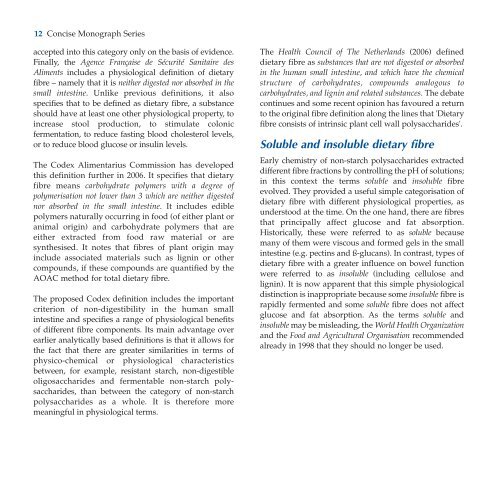Dietary Fibre - ILSI Argentina
Dietary Fibre - ILSI Argentina
Dietary Fibre - ILSI Argentina
Create successful ePaper yourself
Turn your PDF publications into a flip-book with our unique Google optimized e-Paper software.
12 Concise Monograph Series<br />
accepted into this category only on the basis of evidence.<br />
Finally, the Agence Française de Sécurité Sanitaire des<br />
Aliments includes a physiological definition of dietary<br />
fibre – namely that it is neither digested nor absorbed in the<br />
small intestine. Unlike previous definitions, it also<br />
specifies that to be defined as dietary fibre, a substance<br />
should have at least one other physiological property, to<br />
increase stool production, to stimulate colonic<br />
fermentation, to reduce fasting blood cholesterol levels,<br />
or to reduce blood glucose or insulin levels.<br />
The Codex Alimentarius Commission has developed<br />
this definition further in 2006. It specifies that dietary<br />
fibre means carbohydrate polymers with a degree of<br />
polymerisation not lower than 3 which are neither digested<br />
nor absorbed in the small intestine. It includes edible<br />
polymers naturally occurring in food (of either plant or<br />
animal origin) and carbohydrate polymers that are<br />
either extracted from food raw material or are<br />
synthesised. It notes that fibres of plant origin may<br />
include associated materials such as lignin or other<br />
compounds, if these compounds are quantified by the<br />
AOAC method for total dietary fibre.<br />
The proposed Codex definition includes the important<br />
criterion of non-digestibility in the human small<br />
intestine and specifies a range of physiological benefits<br />
of different fibre components. Its main advantage over<br />
earlier analytically based definitions is that it allows for<br />
the fact that there are greater similarities in terms of<br />
physico-chemical or physiological characteristics<br />
between, for example, resistant starch, non-digestible<br />
oligosaccharides and fermentable non-starch polysaccharides,<br />
than between the category of non-starch<br />
polysaccharides as a whole. It is therefore more<br />
meaningful in physiological terms.<br />
The Health Council of The Netherlands (2006) defined<br />
dietary fibre as substances that are not digested or absorbed<br />
in the human small intestine, and which have the chemical<br />
structure of carbohydrates, compounds analogous to<br />
carbohydrates, and lignin and related substances. The debate<br />
continues and some recent opinion has favoured a return<br />
to the original fibre definition along the lines that '<strong>Dietary</strong><br />
fibre consists of intrinsic plant cell wall polysaccharides'.<br />
Soluble and insoluble dietary fibre<br />
Early chemistry of non-starch polysaccharides extracted<br />
different fibre fractions by controlling the pH of solutions;<br />
in this context the terms soluble and insoluble fibre<br />
evolved. They provided a useful simple categorisation of<br />
dietary fibre with different physiological properties, as<br />
understood at the time. On the one hand, there are fibres<br />
that principally affect glucose and fat absorption.<br />
Historically, these were referred to as soluble because<br />
many of them were viscous and formed gels in the small<br />
intestine (e.g. pectins and ß-glucans). In contrast, types of<br />
dietary fibre with a greater influence on bowel function<br />
were referred to as insoluble (including cellulose and<br />
lignin). It is now apparent that this simple physiological<br />
distinction is inappropriate because some insoluble fibre is<br />
rapidly fermented and some soluble fibre does not affect<br />
glucose and fat absorption. As the terms soluble and<br />
insoluble may be misleading, the World Health Organization<br />
and the Food and Agricultural Organisation recommended<br />
already in 1998 that they should no longer be used.

















